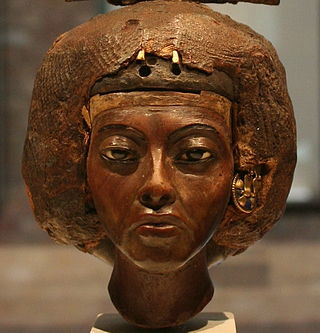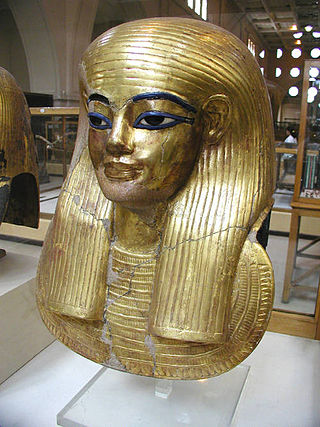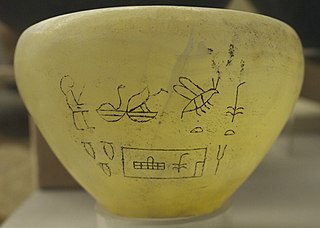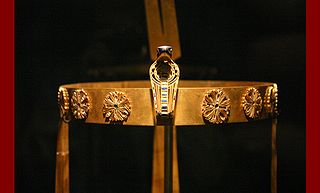
Egyptology is the study of ancient Egyptian history, language, literature, religion, architecture and art from the 5th millennium BC until the end of its native religious practices in the 4th century AD. A practitioner of the discipline is an "Egyptologist". In Europe, particularly on the Continent, Egyptology is primarily regarded as being a philological discipline, while in North America it is often regarded as a branch of archaeology.

Tiye was the Great Royal Wife of the Egyptian pharaoh Amenhotep III, mother of pharaoh Akhenaten and grandmother of pharaoh Tutankhamun; her parents were Yuya and Thuya. In 2010, DNA analysis confirmed her as the mummy known as "The Elder Lady" found in the tomb of Amenhotep II (KV35) in 1898.

Thutmose II was the fourth Pharaoh of the Eighteenth Dynasty of Egypt. His reign is generally dated from 1493 to 1479 BC. His body was found in the Deir el-Bahri Cache above the Mortuary Temple of Hatshepsut and can be viewed today in the National Museum of Egyptian Civilization in Cairo.

Yuya was a powerful ancient Egyptian courtier during the Eighteenth Dynasty of Egypt. He was married to Thuya, an Egyptian noblewoman associated with the royal family, who held high offices in the governmental and religious hierarchies. Their daughter, Tiye, became the Great Royal Wife of Amenhotep III. Yuya and Thuya are known to have had a son named Anen, who carried the titles "Chancellor of Lower Egypt", "Second Prophet of Amun", "Sm-priest of Heliopolis", and "Divine Father".

Winifred Mabel Bruntonnée Newberry was a South African painter, illustrator and Egyptologist.

Semerkhet is the Horus name of an early Egyptian king who ruled during the First Dynasty. This ruler became known through a tragic legend handed down by the historian Manetho, who reported that a calamity of some sort occurred during Semerkhet's reign. The archaeological records seem to support the view that Semerkhet had a difficult time as king and some early archaeologists questioned the legitimacy of Semerkhet's succession to the Egyptian throne.

Mutnedjmet, also spelled Mutnedjemet, Mutnodjmet, Mutnodjemet was an ancient Egyptian queen, the Great Royal Wife of Horemheb, the last ruler of the 18th Dynasty. The name, Mutnedjmet, translates as: The sweet Mut.

John Garstang was a British archaeologist of the Ancient Near East, especially Egypt, Sudan, Anatolia and the southern Levant. He was the younger brother of Professor Walter Garstang, FRS, a marine biologist and zoologist. Garstang is considered a pioneer in the development of scientific practices in archaeology as he kept detailed records of his excavations with extensive photographic records, which was a comparatively rare practice in early 20th-century archaeology.

Guy Brunton was an English archaeologist and Egyptologist who discovered the Badarian predynastic culture. He married Winifred Newberry on 28 April 1906. Her father built Prynnsberg Estate. He served in the First World War and returned to archaeology becoming assistant director of the Cairo Museum in 1931, he retired to South Africa.

Battiscombe George "Jack" Gunn, was an English Egyptologist and philologist. He published his first translation from Egyptian in 1906. He translated inscriptions for many important excavations and sites, including Fayum, Saqqara, Amarna, Giza and Luxor. He was curator at the Egyptian Museum in Cairo and at the University Museum at the University of Pennsylvania in Philadelphia. In 1934 he was appointed Professor of Egyptology at the University of Oxford, a chair he held until his death in 1950.

Menkare was an ancient Egyptian pharaoh, the first or second ruler of the Eighth Dynasty. Menkare probably reigned a short time at the transition between the Old Kingdom period and the First Intermediate Period, in the early 22nd century BC. The rapid succession of brief reigns at the time suggests times of hardship, possibly related to a widespread aridification of the Middle East, known as the 4.2 kiloyear event. As a pharaoh of the Eighth Dynasty, according to Manetho, Menkare's seat of power would have been Memphis.
Warren Royal Dawson OBE FRSE FRSM FZS FSA FLS FRSL was an English librarian, insurance agent, Egyptologist and antiquarian.

The question of the race of ancient Egyptians was raised historically as a product of the early racial concepts of the 18th and 19th centuries, and was linked to models of racial hierarchy primarily based on craniometry and anthropometry. A variety of views circulated about the racial identity of the Egyptians and the source of their culture. Some scholars argued that ancient Egyptian culture was influenced by other Afroasiatic-speaking populations in North Africa, the Horn of Africa or the Middle East, while others pointed to influences from various Nubian groups or populations in Europe. In more recent times some writers continued to challenge the mainstream view, some focusing on questioning the race of specific notable individuals such as the king represented in the Great Sphinx of Giza, native Egyptian pharaoh Tutankhamun, Egyptian Queen Tiye, and Greek Ptolemaic queen Cleopatra VII.

Sithathoriunet was an Ancient Egyptian king's daughter of the 12th Dynasty, mainly known from her burial at El-Lahun in which a treasure trove of jewellery was found. She was possibly a daughter of Senusret II since her burial site was found next to the pyramid of this king. If so, this would make her one of five known children and one of three daughters of Senusret II—the other children were Senusret III, Senusretseneb, Itakayt and Nofret.
Percy Edward Newberry was a British Egyptologist.
Prynnsberg was a manor built between 1881 and 1884 in Clocolan, Free State, South Africa, by Charles Newberry (1841–1922) who immigrated to South Africa in 1864 as a carpenter to join his older brother John, mining in Greytown and eventually gained enough holdings in the Kimberly diamond mining industry to stop actively mining and build his mansion. Charles's daughter was Winifred Brunton.
Khuit I was an Egyptian queen who lived in the mid-5th Dynasty of Egypt.
Brunton is a surname. Notable people with the surname include:
Reginald Engelbach was an English Egyptologist and engineer. He is mainly known for his works in the Egyptian Museum of Cairo, above all the compilation of a register of artifacts belonging of the museum.

Khamure was a ruler of some part of Egypt during the Second Intermediate Period, possibly during the 17th century BC, and likely belonging to the 14th Dynasty. As such he would have ruled from Avaris over the eastern Nile Delta and possibly over the Western Delta as well. His chronological position and identity are unclear.














